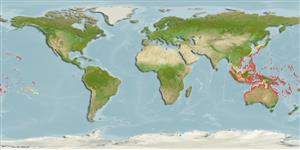Common names from other countries
Environment: milieu / climate zone / depth range / distribution range
экология
морской ассоциированный с рифами; пределы глубины 0 - 60 m (Ref. 128797). Tropical; 37°N - 32°S, 95°E - 134°W
Pacific Ocean: widespread from Japan and Australia to the Tuamoto Islands and Hawaii. Replaced by Chaetodon trifasciatus in the Indian Ocean (Ref. 37816). DNA (from tissue samples) expected to further distinguished Chaetodon lunulatus and Chaetodon trifasciatus (Ref. 86689).
Length at first maturity / Size / Вес / Возраст
Maturity: Lm ?, range 8 - 8.4 cm
Max length : 26.7 cm TL самец/пол неопределен; (Ref. 124696); наибольший вес (опубликованные данные): 191.24 g (Ref. 124696); наибольший возраст (опубликованны данные): 12 годы (Ref. 56281)
Краткое описание
определительные ключи | морфология | морфометрия
колючие лучи спинного плавника (общее число) : 13 - 14; членистые (мягкие) лучи спинного плавника (общее число) : 20 - 22; колючие лучи анального плавника: 3; членистые (мягкие) лучи анального плавника: 18 - 21.
Occur in monogamous pairs in coastal coral-rich areas (Ref. 47838, 48636). Juveniles hide among branches of small corals, often in lagoons (Ref. 9407). Benthopelagic (Ref. 58302). Feed solely on live corals (Ref. 47838). Oviparous (Ref. 205). Form pairs during breeding (Ref. 205).
Life cycle and mating behavior
Maturities | размножение | Spawnings | Egg(s) | Fecundities | личинки
Pairs form upon maturation for breeding purposes (Ref. 56281).
Allen, G.R., R. Steene and M. Allen, 1998. A guide to angelfishes and butterflyfishes. Odyssey Publishing/Tropical Reef Research. 250 p. (Ref. 47838)
Статус Красного Списка МСОП (Ref. 130435)
CITES (Ref. 128078)
Not Evaluated
Угроза для людей
Harmless
Использование человеком
дополнительная информация
инструменты
Специальные отчеты
Скачать в формате XML
ресурсы в Интернет
Estimates based on models
Preferred temperature (Ref.
115969): 24.7 - 29.3, mean 28.3 (based on 1779 cells).
Phylogenetic diversity index (Ref.
82804): PD
50 = 0.5000 [Uniqueness, from 0.5 = low to 2.0 = high].
Bayesian length-weight: a=0.02291 (0.01133 - 0.04632), b=3.00 (2.83 - 3.17), in cm Total Length, based on LWR estimates for this Genus-body shape (Ref.
93245).
Trophic level (Ref.
69278): 3.3 ±0.61 se; based on food items.
устойчивость к внешним воздействиям (Ref.
120179): высокий, минимальное время удвоения популяции до 15 месяцев (Preliminary K or Fecundity.).
Fishing Vulnerability (Ref.
59153): Low vulnerability (17 of 100).
